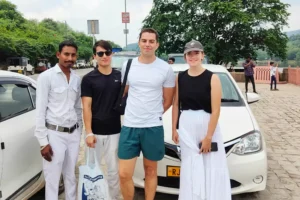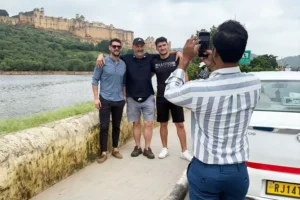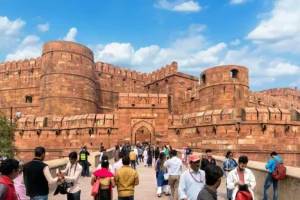The Living Craft of Jaipur: A Journey into Hand Block Printing
— A Real, Raw, Human Experience —
So, here’s the thing about Jaipur—there’s more to it than forts, fancy palaces, and that pink glow everyone talks about.
Just outside the city, if you head a bit off the usual tourist road, you’ll stumble into villages where life moves a little slower. Bagru. Sanganer. The names might not ring a bell right away, but they’ve been doing something pretty incredible for generations. It’s called hand block printing. And honestly? It’s not just a craft. It’s kind of a rhythm they live by.
Walk into one of those homes-turned-workshops, and you’ll know what I mean. Colors are hanging like clothes on a line. Wooden blocks are everywhere—some so worn out, they’ve probably outlived the person who carved them. You’ll see people—sometimes old men, sometimes teenagers—sitting on the floor, just... pressing block after block into cloth, like it’s second nature. No fuss. No big machines. Just hands and habit.
This isn’t some curated “craft experience” made for tourists either. It’s raw. It smells like dye. You’ll probably get ink on your fingers if you hang around too long. And yeah, that’s the point. It’s real.
If you're planning a trip to Jaipur—don’t skip this. Seriously. Go visit one of these workshops. Watch the process. Try it if they let you (some do). You’ll come out with stained palms and a story you’ll tell for years.
Anyway, that’s what this blog’s about. The behind-the-scenes side of block printing in Jaipur—the places, the people, how it all works, how to join a workshop without feeling like you're on a school field trip. It’s all in here. Just scroll on.

The Historical Legacy of Block Printing in Jaipur
The history of block printing in Jaipur and its surrounding regions is deeply woven into the fabric of Rajasthan’s cultural heritage. This ancient craft has thrived for more than four centuries, bringing together Persian influences, Mughal-inspired motifs, and the artistry of local artisans.Origins and Influence
Block printing in Rajasthan dates back over 400 years, when it evolved under royal patronage and influenced by Persian and Mughal designs. These influences enriched the visual vocabulary of Rajasthan’s block prints, introducing new patterns, motifs, and techniques. Jaipur, along with its artisan villages of Sanganer and Bagru, emerged as the cultural and commercial centers for this craft, creating a distinctive art form that became sought after far beyond India’s borders.
Bagru Prints
Bagru, a small village near Jaipur, is renowned for its unique approach to block printing, particularly the Dabu mud-resist technique. In this method, a clay-based paste is skillfully applied to the fabric, which then undergoes a dyeing process that reveals light-colored patterns against dark backgrounds. The artisans of Bagru have preserved this natural dye technique, using eco-friendly and locally sourced dyes in shades of indigo, red, and ochre, giving Bagru prints their earthy and organic look. This approach has made Bagru prints famous for their rustic, hand-crafted charm, embodying the sustainable practices that are intrinsic to this region.
Sanganer Prints
In contrast to Bagru, Sanganer specializes in creating vibrant patterns on lighter backgrounds. The Sanganer style is known for its intricate floral motifs, along with designs inspired by birds and nature, all delicately printed on white or pastel-colored fabrics. These patterns were largely influenced by the Mughal era, which emphasized detailed artistry and fine aesthetic elements. By the 16th century, Sanganer prints had garnered international appeal, especially among European traders, leading the East India Company to export these prints to various parts of the world. Today, Sanganer remains a celebrated name in block printing, with its artisans producing textiles that showcase a refined blend of cultural heritage and artistic finesse.
Through these centuries-old methods, Jaipur’s block printing not only thrives as a craft but continues to connect generations, preserving Rajasthan’s artistry for global admirers.

Techniques in Hand Block Printing
Hand block printing is an intricate and labor-intensive process that highlights the skill and artistry of the craftsmen involved. The following techniques are fundamental to creating the stunning textiles that Jaipur is renowned for.Wood Block Carving
The journey of hand block printing begins with the meticulous art of wood block carving. Skilled artisans carve intricate patterns into wooden blocks, which serve as the primary tools for printing textiles. Each block is designed to represent a different color in the final pattern. The process requires precision and a deep understanding of design, as each detail must be carefully crafted to ensure it aligns perfectly with subsequent colors. These blocks are often made from traditional woods like rosewood or teak, chosen for their durability and fine grain, which allows for sharp, clear prints.
Dyeing and Drying
The vibrant colors seen in block-printed textiles are achieved through natural dyes, sourced from plants, minerals, and other organic materials. Common sources include indigo for blue hues, madder for reds, and pomegranate for yellows and browns. The dyeing process is tailored to the specific pattern being created, and artisans carefully prepare the fabric through techniques such as pre-mordanting, where the fabric is treated to enhance dye absorption. After dyeing, the textiles are spread out to dry under the sun, which not only helps in setting the colors but also adds to the fabric’s texture and character. This natural drying process imbues the fabric with a distinct quality, enhancing its appeal.
Multiple Stages of Printing
Creating the final piece involves multiple stages of printing, where artisans apply each color using a different block. This technique demands a high level of precision; each block must be aligned perfectly with the previous layer to ensure the design is coherent and aesthetically pleasing. The alignment process, known as registration, is crucial, as even a slight misalignment can disrupt the overall pattern. Mastering this skill takes years of practice and a deep intuition for design and color. Artisans often rely on their experience and keen eye to achieve the desired effect, resulting in vibrant, layered prints that reflect both tradition and innovation.
These techniques exemplify the rich heritage of hand block printing in Jaipur, where each step in the process is a testament to the craftsmanship and dedication of local artisans. The combination of wood block carving, natural dyeing, and precise printing creates textiles that are not only visually stunning but also carry the stories and traditions of Rajasthan's artistic legacy.

Immersive Workshop Experiences
For those looking to delve deeper into the world of hand block printing, Jaipur offers a variety of immersive workshops, particularly in the villages of Bagru and Sanganer. These workshops provide a hands-on experience that encompasses every aspect of the block printing process, from the intricate art of carving wooden blocks to the vibrant application of natural dyes.Overview of Workshops
Participants in these workshops have the unique opportunity to learn from skilled artisans who have honed their craft over decades. The sessions typically guide visitors through the entire process, allowing them to understand the cultural significance of block printing while engaging in practical activities. Whether you are a beginner or have some prior experience, these workshops are designed to cater to all skill levels, making them a perfect addition to any travel itinerary.
Popular Workshop Locations
Jai Texart (Bagru): Known for its focus on traditional Dabu printing techniques, Jai Texart offers extensive workshops that emphasize natural dye methods. Participants can immerse themselves in the art of block printing, learning how to create unique designs. Workshops here start around ₹2,000 to ₹3,000 ($25–$36 USD), providing excellent value for the depth of knowledge shared.
Anokhi Museum of Hand Printing: Located near the historic Amer Fort, this museum not only showcases the beauty of block printing but also provides visitors with an interactive experience. Attendees can observe demonstrations of traditional printing techniques and explore historical methods through various fabric samples displayed in the museum.
Rangotri: Situated in Sanganer, Rangotri is another prominent center for block printing workshops. Here, participants are guided through the complete printing process, gaining hands-on experience with both the artistic and technical aspects of the craft. The workshops at Rangotri offer an engaging environment that fosters creativity and learning.
Costs and What’s Included
Most workshops range from ₹2,000 to ₹3,500 ($25–$50 USD), making them an affordable and enriching experience. Typically, the workshop fee includes all necessary materials, such as fabric, dyes, and tools. Additionally, participants often have the chance to create a custom-printed textile to take home as a cherished keepsake, allowing them to remember their unique experience in Jaipur.
These workshops not only provide a creative outlet but also serve as a bridge connecting visitors to the rich cultural heritage of Rajasthan. Whether you’re a textile enthusiast or simply curious about traditional crafts, participating in a hand block printing workshop is a fantastic way to engage with Jaipur’s vibrant artistic community.

Sanganer vs. Bagru Block Printing
Block printing in Jaipur is beautifully represented through two distinct styles: Sanganer and Bagru. Each has its unique techniques, aesthetics, and historical significance, showcasing the rich artistic heritage of Rajasthan.
Bagru Block Printing
Bagru block printing is celebrated for its commitment to traditional methods, particularly the use of natural dyes and the distinctive mud-resist technique known as Dabu.
Natural Dyes and Dabu Technique: Artisans in Bagru employ a clay-based paste made from natural materials to cover specific areas of fabric before dyeing. This paste acts as a resist, preventing the dye from penetrating those sections during the coloring process. As a result, the fabric emerges with striking light patterns against a darker background, creating a unique contrast that is both earthy and organic.
Color Palette: The dyes used in Bagru are derived from natural sources, such as indigo and pomegranate, ensuring an eco-friendly approach. The color palette is typically more subdued, featuring deep blues, browns, and reds that resonate with the natural environment.
Designs and Aesthetics: Bagru prints often feature bold, geometric designs and motifs inspired by local flora and fauna. The focus is on a rustic charm, emphasizing the artisanal nature of the craft and the beauty of imperfection.
Sanganer Block Printing
In contrast, Sanganer block printing is known for its delicate and intricate designs, often characterized by a vibrant use of color.
Intricate Designs: Sanganer prints are renowned for their fine detailing and elaborate motifs, typically featuring floral patterns, birds, and other nature-inspired elements. The craftsmanship reflects a high level of artistry, making Sanganer prints highly sought after.
Vibrant Color Use: Unlike the more muted tones of Bagru, Sanganer prints often showcase a bright and vivid color palette against white or light backgrounds. This approach enhances the visual appeal and makes the patterns stand out, creating an eye-catching effect.
Cultural Influences: The designs from Sanganer are heavily influenced by Persian artistry, which was introduced during the Mughal era. The intricate detailing in Sanganer prints can be traced back to trade connections with the East India Company in the 16th century, where these textiles became popular commodities in global markets.

Choosing the Right Workshop: What to Expect
Participating in a block printing workshop in Jaipur is an enriching experience that goes beyond mere craftsmanship. Here’s what you can look forward to when you choose to attend one of these workshops:
Hands-On Activities
Workshops are designed to be interactive and engaging, providing participants with the chance to dive deep into the art of block printing. Here are some of the hands-on activities you can expect:
Block Carving Demonstrations: Skilled artisans will often begin the workshop by showcasing the intricate process of carving wooden blocks. Participants may have the opportunity to try their hand at this fundamental step, learning about the importance of precision and design in creating patterns.
Dye-Making: Many workshops include sessions on natural dye-making, where participants can learn how to create vibrant colors using organic materials. This aspect not only highlights the eco-friendly approach of traditional block printing but also gives attendees a deeper understanding of the materials used in the process.
Printing on Fabric: The most exciting part of the workshop is often the actual printing process. Participants will be guided through applying dyes to fabric using the carved blocks, allowing them to create their unique designs. Expect to walk away with a custom-printed textile that you can cherish as a personal keepsake.
Cultural Insights
In addition to the technical aspects of block printing, workshops often emphasize the rich cultural heritage behind this art form.
Artisan Stories: Many artisans take the time to share their personal stories, detailing the legacy of their craft and how techniques have been passed down through generations. These narratives add a profound layer of meaning to the experience, connecting participants to the cultural significance of block printing in Rajasthan.
Historical Context: Workshops often include discussions about the historical influences on block printing, including how trade routes, royal patronage, and cultural exchanges shaped the styles and techniques seen today.
Time Requirements
Most workshops are designed to fit into a variety of schedules, making them accessible for both tourists and locals.
Duration: Expect workshops to last between 2 to 5 hours, providing ample time to engage in hands-on activities and absorb the insights shared by the artisans.
Half-Day Tours: For those interested in a more comprehensive experience, many workshops in Bagru include village tours that last half a day. This allows participants not only to learn about block printing but also to explore the local culture and environment, making them an ideal option for day-trippers from Jaipur.

Practical Tips for Attending a Workshop
When planning to attend a block printing workshop in Jaipur, keeping a few practical tips in mind can enhance your experience and ensure you make the most of this unique opportunity.
Best Time to Visit
Ideal Months: The best time to visit Jaipur for block printing workshops is during the dry, sunny months from October to April. This period offers pleasant weather, and the abundant sunlight is essential for setting dyes properly. The warm climate allows for efficient drying, ensuring the colors are vibrant and well-fixed.
What to Bring
Comfortable Clothing: Since workshops often involve dyeing and printing, it’s advisable to wear comfortable, casual clothing that you don’t mind getting a bit messy. Consider wearing older clothes or an apron, as the dyes can stain.
Cameras: Don’t forget to bring your camera or smartphone! The vibrant hues and intricate designs created during the workshop provide excellent photo opportunities. Capturing these moments allows you to remember the experience and share it with others.
Supporting Local Artisans
Purchasing Directly: When you attend a workshop, consider buying textiles directly from the artisans. This not only helps sustain local craftspeople but also preserves the authenticity of the block-printed fabrics. By purchasing from workshops, you contribute to the local economy and ensure that these traditional skills continue to thrive.
By following these practical tips, you can maximize your enjoyment and engagement during your block printing workshop in Jaipur, making it a memorable part of your travel experience.

Sustainability and Revival of Block Printing
The tradition of hand block printing in Jaipur is not only a celebration of artistic expression but also a model of sustainability. As the demand for eco-friendly practices grows, many workshops and organizations are committed to preserving this craft while minimizing environmental impact.
Eco-Friendly Practices
Natural Dyes: Many block printing workshops prioritize the use of natural dyes derived from plants, minerals, and other organic materials. This approach ensures that the dyeing process is eco-friendly, reducing the reliance on synthetic chemicals that can harm the environment.
Traditional Techniques: Artisans employ time-honored techniques that have minimal impact on the ecosystem. These methods not only preserve the integrity of the craft but also emphasize a sustainable approach to textile production, which aligns with contemporary consumer values.
Revitalizing the Craft
Cultural Tourism: Block printing has experienced a revival in recent years, fueled by an increasing interest in cultural tourism. Tourists are seeking authentic experiences that connect them to local traditions, making workshops a popular activity. This demand supports artisans and ensures the continuation of their craft.
Collaborative Efforts: Organizations like the Anokhi Foundation and Jaipur Rugs play a pivotal role in revitalizing block printing. They collaborate with artisans to enhance their skills, improve working conditions, and promote their products in national and international markets. These initiatives help sustain the heritage of block printing while empowering the artisans financially.
By embracing sustainable practices and fostering a revival of traditional crafts, the block printing community in Jaipur not only preserves a rich cultural legacy but also addresses modern consumer demands for ethical and environmentally friendly products.
Conclusion
Hand block printing workshops in Jaipur offer a meaningful way to engage with Indian culture. By learning and supporting this traditional art form, visitors take home more than just printed fabrics—they gain an understanding of Jaipur’s vibrant heritage and support a craft that continues to thrive through the passion of its artisans.
Have Questions? Call Us Today!
Phone: 095719 15083
Email: enquiry@rajasthantourdriver.com












